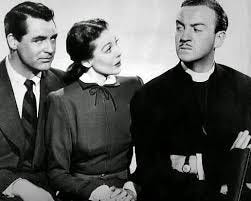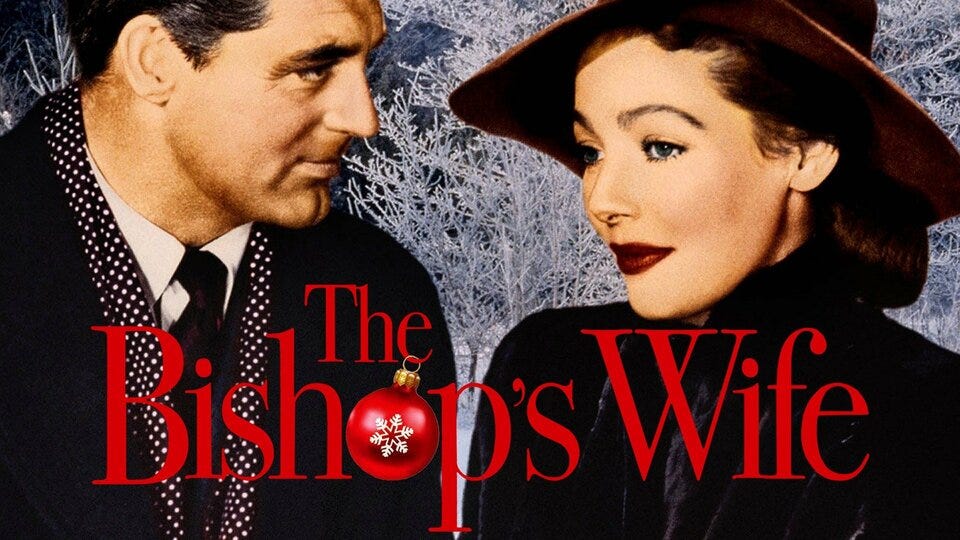I love that the holiday season is full of movies with themes that are relevant for us who work at nonprofits. My favorite is the 1947 comedy, The Bishops Wife.
In the opening scenes of the film, we glimpse the bishop’s wife, played by Loretta Young. Snow is falling as she window shops amongst other busy Christmas shoppers, but she is clearly sad. We learn that her once-happy marriage is suffering. Bishop Henry Brougham, played by David Niven, has lost sight of what is important in life. He is obsessed with raising funds to build an impressive and imposing new cathedral, to the detriment of his family and the members of his local parish. He sets out, come hell or high water, to make it happen. But he starts to lose focus on what matters most, he succumbs to what we might call mission-drift, even becoming a bit of a sell-out. Comedy ensues as he muddles his way through increasingly awkward situations and eventually gets back on the right track.
Fundraising Don’ts
The following film scene provides a good lesson in what not to do in fundraising. In an intense meeting in a wealthy donor’s home, Bishop Brougham allows a donor to run roughshod over him:
Bishop Henry Brougham: My dear Mrs. Hamilton, upon consideration, my objections seem petty with the generosity of your gesture…
Mrs. Hamilton: Now, I’m taking it for granted that the George B. Hamilton Memorial Chapel shall be located…
Bishop (sighs): Just where you specified…
Mrs. Hamilton: You no longer feel the effect will be that it was built in my husband’s honor?
Bishop: That was said in dispute. What matters is that the cathedral be built.
Mrs. Hamilton: Good. I will not have his name on some horrid little brass plaque.
Bishop (privately sarcastic): No. It will be incised in marble. Large letters. Gilded.
Mrs. Hamilton (missing the sarcasm): That large window depicting St. George and the dragon. I should like that the countenance of St. George suggests my late husband.
Bishop (again, privately sarcastic): Yes. Who do you see as the dragon? [i]
Yikes! There are so many problems with this interaction. The bishop is insincere. While it is essential for a donor to feel connected and personally invested in a nonprofit project, the donor should never take over. The behavior of both parties violates the integrity of the organization and its community of stakeholders.
The Bishop’s Wife is one of my favorite Christmas movies because each of the characters rediscover what is most important.

Thanks to the playful scheming of an intervening angel played by Cary Grant, the bishop, the donor, and others, learn key lessons and find their way. I also love that there are some helpful lessons for nonprofits.
Sometimes We Need To Say No
Leaders have the unenviable responsibility of sometimes turning away funding if the proposed project does not align with the organization’s mission and scope. This might be excruciatingly hard to do. A nonprofit can be in danger of being spread too thin and becoming ineffective. Doctors Without Borders returned $500,000 of restricted funds that they felt they could not spend effectively.[ii] Yale returned a $20 million gift from a donor who they said wanted inappropriate control of the use of the money.[iii]
A fundraising professional told me about a time her nonprofit was part-way through a funded project when the leadership team realized the project wasn’t working, that it was not right for them, and they would not meet the donor’s intent. The nonprofit ended the project and apologetically returned the grant money they had not yet spent and explained why. The grant maker was very understanding, and so pleased with the nonprofit’s integrity that they gave the nonprofit even more funding for a different project the following year.
But as we know, turning away money to maintain mission integrity is easier said than done. Are we clear about our vision, mission, priorities, and organizational identity? This clarity provides boundaries for what is in scope or out of scope and empowers us to confidently say no to things and stay true to our north star. Are we stress-testing our assumptions from time to time to make sure our vision remains relevant in a constantly changing landscape? I unpack this in more detail in my book, Innovation for Social Change: How Wildly Successful Nonprofits Inspire and Deliver Results.
I would love to hear about your experience with these questions. Was there a time when you wished you would have said no to a donor?
[i] https://www.scripts.com/script.php?id=the_bishop%27s_wife_19788&p=19 (emphasis added)
[ii] Harvey McKinnon, The 11 Questions Every Donor Asks And the Answers All Donors Crave
[iii] Roger D. Silk, James W. Lintott, Managing Foundations and Charitable Trusts: Essential Knowledge, Tools, and Techniques for Donors and Advisors

